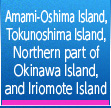- Ministry of the Environment>Nature & Parks>
- World Natural Heritage in Japan>
- Ogasawara Islands>
- Protection and management
Protection and management
The Ecosystem Conservation Action Plan, which denotes
a specific plan of action for resolving ecosystem-related
challenges on the Ogasawara Islands, was prepared by the
national government, the Tokyo Metropolitan Government,
and Ogasawara Village. On the basis of this plan, protection
and management efforts are being promoted.
The large number of endemic species on the Ogasawara
Islands is highly evaluated internationally. Yet many of those
do not know how to protect themselves from the species
artificially introduced to Ogasawara later on. The endemic
species are being preyed upon by the alien species and deprived of the areas where they live, so their numbers
are plunging precipitously. In order to preserve the Outstanding Universal Value of the Ogasawara Islands, it is
extremely important that countermeasures be taken against alien species and that the protection of endemic
species and other rare species be promoted. In line with the advice of the Scientific Committee, adaptive management
is carried out that evaluates the current situation by considering the interaction of wildlife and accordingly
adjusting countermeasures.
- Protected Areas in the Property
Ogasawara National Park Special Protection Zone: 4,934 ha Special Zone: 996 ha Minami-iwoto Wilderness Area: 355 ha - (Under jurisdiction of MOE)
Examples of Efforts
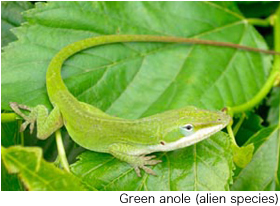
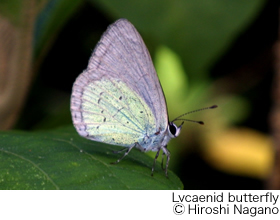
Measures for the Restoration of Endemic Insect Species
The invasive green anole is found throughout Chichijima and Hahajima islands. Preying on and reducing populations of rare endemic insect species including the endemic lycaenid butterfly, the green anole has had a devastating impact. In 2013, it was found to have reached the southern areas of Anijima Island, where unique endemic insect fauna remain, raising concerns about its impact on endemic tiger beetles and other endemic insect species.
To protect the ecosystem in the heritage site, enclosures to prevent incursion by green anoles have been set up at Shin-yuhigaoka on Hahajima Island. The intensive control measures within these enclosures have led to the recovery of endemic insects. On Anijima Island, efforts are being made to control the expansion of anole habitat by installing anole fences across the island and capturing anoles using adhesive traps. In addition, monitoring of anole invasion and insect habitat is also conducted to conserve endemic insect fauna.
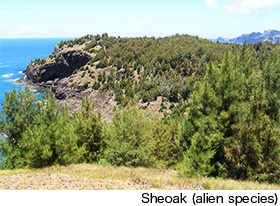
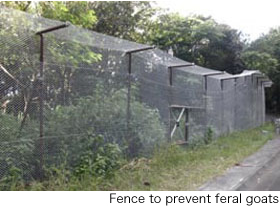
Countermeasures against Alien Species for the Restoration of Native Vegetation
Countermeasures against Alien Plant Species
The proliferation of alien plant species like sheoak, white leadtree, and Bishop wood inhibits native plant growth by altering the forest interior, including blocking out sunlight and breezes. These alien plant species also affect the habitat of endemic insect species—for example, by blocking sunlight and generating leaf litter. In the Ogasawara Islands, efforts are being made to eradicate alien plants such as by injecting chemicals into the trunks.
Countermeasures against Feral Goats
Feral goats trample and forage on endemic species and other plants, activities that have enormous impact on ecosystems. Feral goats have been successfully eradicated from the uninhabited islands of the Ogasawara, and endemic vegetation is recovering in some locations. Currently, feral goats are found only on Chichijima Island. In Higashidaira area, where numerous endemic plant species are found, fences to prevent incursion by feral goats have been set up.
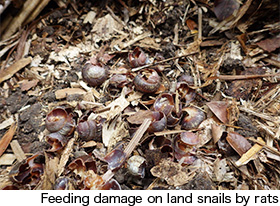
Measures to Conserve Endemic Land Snails
Endemic land snails inhabiting the Ogasawara Islands are under threat of extinction due to predation by alien rodent species such as the black rat and alien planarian species. Various measures have been taken to prevent land snails from becoming extinct, including use of rodenticide to eradicate black rats and installation of enclosures to prevent incursion by planarians, as well as informing visitors and islanders about shoe sole washing to prevent the spread of planarians.
In addition, the Ministry of the Environment has been rearing land snails at indoor and outdoor captive facilities on Chichijima Island since 2011 as an ex-situ conservation measure. In 2020, an ex-situ population of land snails (Mandarina chichijimana and Mandarina hirasei) were released into the wild on Tatsumijima Island, an island belonging to Chichijima Island.





